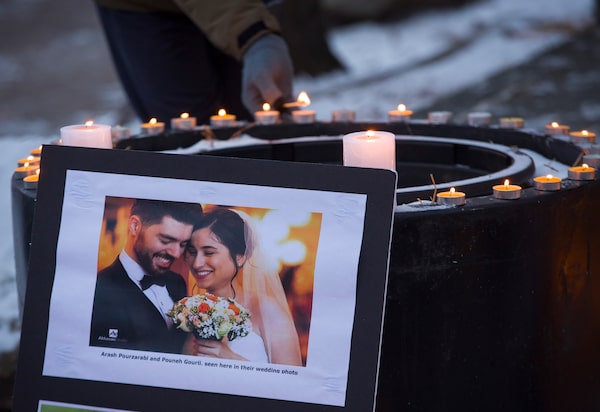A makeshift memorial honours some of the students at the University of Alberta in Edmonton who were killed in the Ukrainian airlines disaster this week in Iran.Todd Korol/The Globe and Mail
Pouneh Gorji was a tireless researcher, focused on how to use artificial intelligence for detecting liver ailments from ultrasound images.
Her home department at the University of Alberta was computing science. But Ms. Gorji embraced being an interdisciplinary student, said her graduate supervisor Pierre Boulanger. She worked closely with radiologists at the faculty of medicine as she pursued her master’s degree.
“Before she left for her wedding in Iran, she made great progress and was ready to publish her work in top academic journals,” Dr. Boulanger said this week. “She was truly knowledgeable and smart."
The passengers of UIA Flight 752: What we know about those we lost in the disaster
The 25-year-old grad student won’t ever see her published work. She died in the Ukraine International Airlines crash that killed 176, just one week after her wedding day in her home country of Iran.
“What a loss for the world,” Dr. Boulanger said.
Families and friends are living through unimaginable grief as they mourn victims of the Ukraine International Airlines Flight 752 crash in Iran. Many of those who died were also exceptional minds and key players in the world of Canadian academia and research – and the loss of knowledge, intellect and potential is staggering.
In Edmonton, the University of Alberta’s faculties of engineering and science have been particularly touched by the disaster. Many from the university community on Flight 752 — a total of 10 that included professors, students and alumni — did cutting edge research in areas as varied as developing low-cost, low-power wireless technology to unraveling the mysteries of the human placenta. Their skills and talent are far from being easy to replace.
Ms. Gorji’s groom, Arash Pourzarabi, was another key member of a two-decade-old AI research community at the university.
“Research in AI almost never happens with transcendent breakthroughs, but rather through a slow build-up,” said Mr. Pourzarabi’s supervisor Michael Bowling, who remembers the grad student’s bright smile and meticulous, handwritten notes.
A makeshift memorial adorns the door of Pedram Mousavi's office at the University of Alberta's engineering department in Edmonton. Mousavi was one of the people killed in the Ukrainian airline disaster in Iran this week.Todd Korol/The Globe and Mail
With others, they were working on the fundamental problem of how to get AI systems to respond to new, unforeseen situations. "Arash’s work would have been part of the communal scientific advance.”
Among the other victims, engineering professor Pedram Mousavi had acted as a key bridge between industry and the university for research in wireless technologies, and had hoped to create new types of job opportunities in the province known for its oil and gas industry. His wife, fellow U of A professor Mojgan Daneshmand, had worked on using radio frequencies and microwave sensors for industrial monitoring and sensing.
Nasim Rahmanifar was working on her master’s in mechanical engineering, but had been given an offer to transfer to the PhD program, said her supervisor Hossein Rouhani, who described Ms. Rahmanifar as a future Canadian “star.” Her research focused on methods to reduce injuries, repetitive strain and pain in wheelchair users.
Somehow, Dr. Rouhani wants to find a way to continue her important work. But finding someone who can take up the mantle will be difficult.
“Nasim was one of the best students the University of Alberta could get,” he said. “She could be a role model for all female students who are looking for an academic or research-oriented career.”

A photo of Arash Pourzarabi and Pouneh Gorji is shwon during a memorial for the victims of crash of the Ukraine International Airlines flight near Tehran this past week in Calgary, Friday, Jan. 10, 2020.Todd Korol/The Canadian Press
The University of Alberta's engineering department where some professors and students worked who were killed in Ukrainian airline disaster in Iran this week, in Edmonton, Alberta, January 9, 2020. Todd Korol/The Globe and MailTodd Korol/The Globe and Mail
Saba Saadat, 21, “was such an exceptional student, I’m not sure I will ever meet one like her again," said Meghan Riddell, an assistant professor in the department of obstetrics and gynecology.
“She was a PhD disguised as an undergrad," she said of the fourth-year science student.
Dr. Riddell said Ms. Saadat wanted to be a medical doctor. But first, Ms. Saadat was recruited to work on research on placenta-related pregnancy complications, such as pre-eclampsia, or when babies are born very small.
The complicated work included trying to solve problems related to replicating the growth of a placenta in a lab, for study purposes.
“That’s a pretty crazy project to propose with an undergraduate,” Dr. Riddell said.
“Her mind is one thing to focus on," she added. "But she was just the whole package. She was also, perhaps, the most empathetic person I have met in my whole life.”
 Kelly Cryderman
Kelly Cryderman